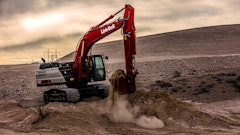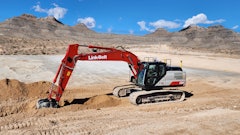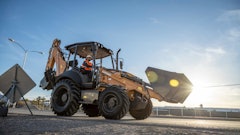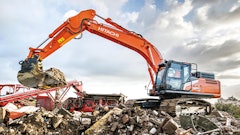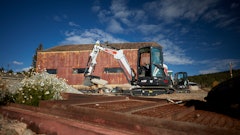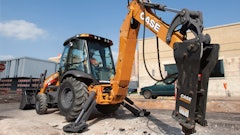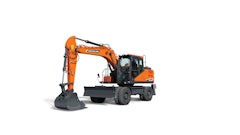Specs such as horsepower, operating weight and dig depth/reach typically garner initial attention with an excavator. But the bucket at the end of the stick can also have a tremendous effect on how well a particular machine performs on a jobsite. And, since a bucket can last the lifetime of its host, it makes sense to pay attention to its selection.
Your customer's goal is to scoop up the maximum amount of whatever material they're moving. Accomplishing that usually requires creating a balance between capacity and application. Mount a bucket that's too large for the application and you might excavate more than is necessary or, worse yet, cause damage to the bucket or machine and/or compromise operator safety. Mount one that's too small and it will simply take too much time to dig.
There is a wide array of buckets available - everything from general-purpose, heavy-duty and severe-duty buckets to specialty buckets such as those for digging and moving rock, coral and lava. The differences between them center around abrasion resistance and wearability, as well as the ground engaging tools (GET) attached to the digging edge. They can also be spec'd in a variety of capacities and widths. In addition, specialty buckets are available with a variety of designs, shapes (i.e., V-shaped) and GET.
How tough does it need to be?
It's crucial to use the right bucket, since a misstep can reduce productivity and lead to premature wear.
"If you use a general-purpose bucket in rock, you can break it and cause failures, which create downtime and replacement costs," says Greg Cveykus, director of engineering, Kenco. "There aren't too many detrimental effects for using a heavy- or severe-duty bucket in light soils. But if you do the majority of your work with a heavy-duty bucket in a general-purpose environment, you have more equipment investment than needed."
A general-purpose bucket will typically be of higher capacity. Many are also smooth lipped. If they do have teeth, they are usually wider and closer together to provide added capacity.
"They are meant for black dirt conditions," notes Cliff Gabriel, regional sales representative, Werk-Brau.
General-purpose buckets are typically made of lighter-grade steel. Wear plates and guards can be added for increased durability, and wear straps, if used, will run with the same radius as the bucket.
Heavy- and severe-duty buckets are made of increasingly heavier grade steel, such as T-1 or AR400 or 500, to better withstand abrasive working conditions, including dense clay, sand and gravel, as well as rock, shot rock and stone.
These buckets do not need to be hardfaced; doing so can actually be detrimental. "Welding heats up the bucket and, as it cools, it shrinks and puts stress concentrations on the surface," says Lee Horton, president, Leading Edge Attachments. "These harder steels are more likely to crack under these conditions."
To endure the more severe working conditions, the buckets will have a thicker front lip with horizontal straps across the back and a thicker bottom or back plate. GET runs the gamut from wide teeth to rock-penetrating points.
"Over the last two years, we've seen a dramatic change from the general-purpose to the heavy-duty bucket to cover multiple applications," says Gabriel. "That's because a heavy-duty bucket is more versatile and can dig black dirt as well as rock."
To determine which type of bucket is best for your application, consider where you're digging. "Soil conditions across the United States are different," Gabriel says. "In Wisconsin, you may be able to use a general-purpose bucket with high capacity. But if you're digging in Miami, you will likely need a coral bucket - a severe-duty bucket with teeth close together so it can chip away at the ground."
Various soil types also have different weights. Those weights become important when you consider how the bucket will be used, i.e., digging over the side (which will reduce capacity) or front/back.
"To be productive, you will want to get the largest bucket you can for the material and working conditions," says Horton. "If you have light, soft material, you can get away with a larger bucket. If you get to very hard soil or even rock or compressed conglomerate material, you need a shorter, smaller bucket to keep your breakout force high enough."
"What can be a selling point on a machine that might have a higher breakout force based on horsepower can be negated, or made up, [based on] the bucket or bucket/coupler combination," adds Gabriel. "That would take away, or add to, a competitive advantage."
Size matters
Lift capacity of a given machine also affects the size of the bucket, says Kirk Yoresen, marketing communications manager, ESCO. Be aware that stick configurations can affect load, i.e., excavators with extended booms can carry less weight.
"You want to make sure you're not asking the bucket to do too much for the available machine power," he adds. "Performance goes down and safety can become a concern.
"If bucket capacity goes beyond the lift capacity, stability issues can come into play," Yoresen continues. "If an operator is working on a high wall loading heavy material, good stability becomes much more important for safety."
A bucket that's too large can also decrease breakout force, since the tip radius (distance from the stick pivot to the tip of the teeth) is in direct inverse proportion to the amount of force you get when you dig.
"The shorter the tip radius, the higher the force at the tooth tips," explains Horton. "Also, the fewer the number of teeth you have engaging the material, the more force you have on the tooth tips. With our multi-ripper bucket, we have one tooth hitting at a time. Plus, it's short, so when you roll the bucket, you can dig through frozen ground and rock."
Sizing the bucket also includes taking the width into account. Width can be of particular concern if you are digging trenches for utility lines. "You don't want to dig more than you have to," Horton states. "If you dig too much, you're wasting time and money."
Wide buckets can be used in soil that is easy to dig, but you will likely want a narrower bucket for harder soil conditions. That's because the stick and curl forces of a wider bucket are spread over a larger area, so there is less penetration per inch of bucket cutting edge.
When assessing bucket width, also be sure to check the width of the connection point. "You may have a particular size machine and not realize that the connection at the top of the bucket is wider than the bucket width you want to use," says Tony Freidhoff, engineer, Kenco.
Effect of couplers
Couplers give you the ability to change buckets based on the application at hand. "A coupler makes it faster and easier to change buckets," says Horton. "Once you make it faster and easier, you can pick the right bucket for the job."
On the other hand, it's important to take notice of which coupler you're using. Depending on the type, it can change the geometry of the machine and reduce its breakout force.
A dedicated coupler, which is integral to the machine, has minimal affect since it maintains the highest possible digging power. "In this scenario, virtually no other aspects come into bucket selection because the tip radius of the bucket and the machine remains the same," says Cveykus. "The breakout force, bucket rotation, etc., of the machine all remain virtually the same as the OEM specifications."
Adding a hydraulic pin grabber coupler, on the other hand, could move the bucket farther away from the machine, adding to the tip radius. "That could reduce the breakout force, depending on the bucket and machine configuration," says Gabriel.
Tip radius measurement affects the bucket curling force. A bucket with a short tip radius provides more curling force than one with a longer tip radius, facilitating easier loading of material.
Your bucket manufacturer can help you calculate the affect a coupler might have on the breakout force of your machine. "You certainly want to account for it so you don't tip the machine," says Yoresen. "You need to be aware that there will be a reduction in breakout force because you're changing the geometry of the machine relative to the bucket. When you change the geometry - the relationship of the bucket arm to the tip of the bucket - it affects the available machine power."
Cveykus adds, "In this case, if you had a pin grabber quick coupler and you wanted to dig in heavy shale or hard ground, you might want to go with a lower capacity, shorter bucket. It can regain some of that lost tip radius, and therefore regain some of that lost breakout force."
In the end, there are a lot of factors to consider when selecting a bucket for a particular task. "Don't be tempted to save a few dollars in the cost of your bucket," advises Yoresen. "It may end up costing you more money in downtime and repair costs."
Tips to Match the Right GET GET are designed in a variety of styles (forked, spade, pointed, flat paddle, etc.) to work in a variety of conditions. Selection typically boils down to identifying whether you need more wear metal or penetration. Teeth strengthened with a lot of wear metal won't penetrate tough ground conditions as easily as high-penetrating, sharp teeth, which have a smaller amount of steel but wear more quickly. "It becomes a balancing act and a trade-off between wear metal and penetration," says Kirk Yoresen, ESCO. Tooth spacing is another consideration. A high number of wide teeth spaced closer together act as a primary edge and hold more material, while those that are narrower and spaced farther apart can chip away at abrasive material. Also pay attention to tooth size. "When applying a tooth on a given bucket in general-purpose to heavy-duty conditions, you may be able to use a smaller tooth," says Yoresen. "With a smaller tooth size, replacement is cheaper, you use less fuel and it's easier to get teeth to go through material. But if you're going to be in rough conditions, you will want a bigger system (tooth and holder) to withstand more power. That does require a bit more machine power to go through material, but you don't have to worry about breakage." Although teeth bear the initial brunt when digging, the adapter (also referred to as shank, keeper, etc.) must also be able to withstand a particular application. Some adapters are welded onto the bucket, while others are bolted on. "You will want to select one that can withstand the force that it sees," says Tony Freidhoff, Kenco. "A machine that weighs many tons that is pulling at full machine power has constant forces that work against the teeth," explains Yoresen. "Make sure you have a really strong adapter that is strong enough to withstand the machine power." |












